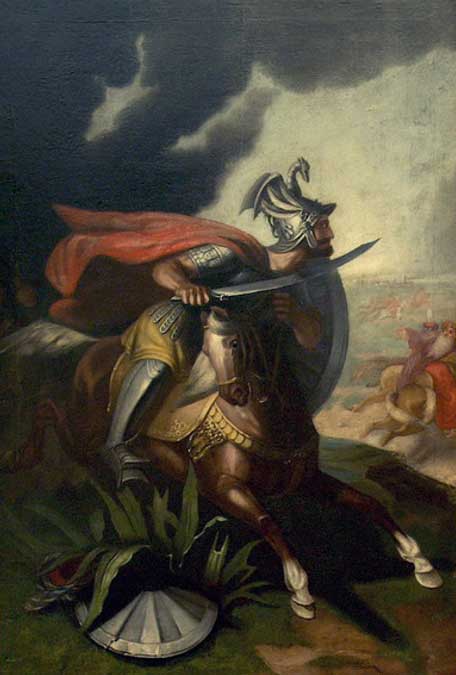
Serbia and the Ottoman Empire: The Loss and Recuperation of Independence
During the second half of the 14th century, the Ottoman Empire was extending its rule into the Balkans. One of the regional powers that the Ottomans encountered during their conquest of the Balkans was the Serbian Empire, which was established by Stefan Dušan, ‘the Mighty’ of the Nemanjić Dynasty during the first half of the same century.
The Serbian State During the Middle Ages
The history of the state of Serbia may be said to have its beginnings in the Middle Ages. Between the 6th and 11th centuries AD, the Slavic ‘invasion’ of the Balkans brought the Serbs into this region. During these early years, there was no unified Serbian state, but a number of tribes. It was under the Nemanjić Dynasty in the 13th century than Serbia rose as a dominant power in the Balkans, and achieved its golden age under Stefan Dušan.
Following Stefan Dušan’s death in 1355, the throne passed to his son, Stefan Uroš V, ‘the Weak.’ This was the beginning of the decline of the Serbian Empire, which would eventually be conquered by the Ottoman Empire, and would remain occupied by this power until the 19th century.

Fresco of Serbian Emperor Stefan Dušan. (14th Century), Lesnovo Monastery, Republic of Macedonia. (Public Domain) and his son Stefan Uroš V of Serbia. (Public Domain)
The Battles with the Ottoman Empire
There were two crucial battles in the Ottoman conquest of the Serbian Empire. The first of these was the Battle of Maritsa that took place in 1371. During this battle, the numerically superior Serbian army was defeated by a much smaller Ottoman army as a result of the latter’s use of superior tactics. During the battle, Vukašin Mrnjavčević, the King of the Serbs and Greeks, and the co-ruler of Emperor Stefan Uroš V, was killed along with his brother, despot Uglješa. The loss of this battle led to the conquest of Macedonia and parts of Greece by the Ottomans.
The second, and perhaps more famous battle, was the Battle of Kosovo, which took place in 1389. Although the Nemanjić Dynasty came to an end after the death of Emperor Stefan Uroš V (who left no heir) several months after the Battle of Maritsa, it was not the end for the Serbs. There were still feudal lords holding power in the Empire, and one of the most powerful of these was Lazar Hrebeljanović. Prince Lazar was able to unite most of Serbia, and prepared to face the invading Ottomans.
- 2,500 Year-Old Ancient Warriors Unearthed in Serbia
- Zmaj and the Dragon Lore of Slavic Mythology
- Researchers getting warmer in the hunt for heart of Suleiman the Magnificent
- From Here to Eternity: the Tragic Tale of the Dance of Zalongo
The Battle of Kosovo is regarded today as tactically inconclusive and both the Serbs and the Ottomans sustained heavy losses. Amongst the dead were Prince Lazar and Sultan Murad I. According to one account, a Serbian knight by the name of Miloš Obilić stabbed the sultan whilst kneeling in submission.

Miloš Obilić, a Serbian knight that allegedly stabbed Sultan Murad I during the Battle of Kosovo in 1389. (1861) by Aleksandar Dobrić. Belgrade National Museum. (Public Domain)
Nevertheless, the Serbs fared much worse in comparison to the Ottomans in the aftermath of the battle. The Serbians were left without an army to defend their lands, though the Ottomans still had a large amount of troops in the east. Additionally, many of the Serbian leaders, including Lazar’s successor, became Ottoman vassals. Serbia eventually lost its independence in 1459.
Serbian Life Under Ottoman Rule
It has been said that the Serbs suffered immensely under Ottoman rule. Determined to exterminate the social elite, the Ottomans persecuted the Serbian aristocracy. Additionally, it has been claimed that the Christian Serbs lived as “virtual bond servants – abused, humiliated and exploited” under the rule of their Muslim overlords. As a result, the cities were gradually abandoned, and many of the inhabitants withdrew to the mountains, where they adopted a pastoral lifestyle.
Christian Europe was not of much help to the Serbs. Instead, as they were constantly at war against the Ottomans, the Serbs became a pawn in their game. These powers often sought to incite the Serbians to rebel against their masters, though such uprisings often ended in failure.

Painting depicting the burning of Saint Sava's remains. (Public Domain) When this event took place following the Banat Uprising, Serbs in other regions were incited to revolt against the Ottomans as well.
Serbia’s Independence
The year 1804 marked the beginning of a series of revolts that would lead to Serbia’s independence from Ottoman rule in 1878. During the early years of the uprising, a small autonomous Serbian principality was established by Prince Milos Obrenovic. Milos’ descendants ruled over this new principality for the following decades, and the Serbian leaders were able to consolidate their power. Finally, between 1876 and 1878, the Serbs fought a war with the Ottomans, which ended in regaining their full independence.
Featured image: A painting depicting the Battle of Kosovo (1870) by Adam Stefanović. Prince Lazar is seen dying with his horse at the left. Photo source: (Public Domain)
By: Ḏḥwty
References
Balkan Military History, 2005. The Battle of Kosovo. [Online]
Available at: http://www.balkanhistory.com/kosovo_1389.htm
BLAGO Fund, Inc., 2014. Serbian Medieval History. [Online]
Available at: http://www.srpskoblago.org/serbian-medieval-history/
Cryer, A. B., 2015. Battle of Maritsa explained. [Online]
Available at: http://everything.explained.today/Battle_of_Maritsa/
Miller, W., 1921. The Medieval Serbian Empire. [Online]
Available at: http://www.shsu.edu/~his_ncp/MillSerb.html
Sowards, S. W., 1996. Lecture 5: The Serbian Revolution and the Serbian State. [Online]
Available at: http://staff.lib.msu.edu/sowards/balkan/lecture5.html
TravelSerbia.Info, 2013. Serbia Under Turkish Rule (14th-19th Century). [Online]
Available at: http://www.travelserbia.info/history/ottoman.php
www.balkaninsight.com, 2010. Timeline: The Ottomans and the Balkans. [Online]
Available at: http://www.balkaninsight.com/en/article/the-ottomans-six-centuries-in-europe
www.historyworld.net, 2015. History of the Ottoman Empire. [Online]
Available at: http://www.historyworld.net/wrldhis/PlainTextHistories.asp?ParagraphID=mqf#1621















